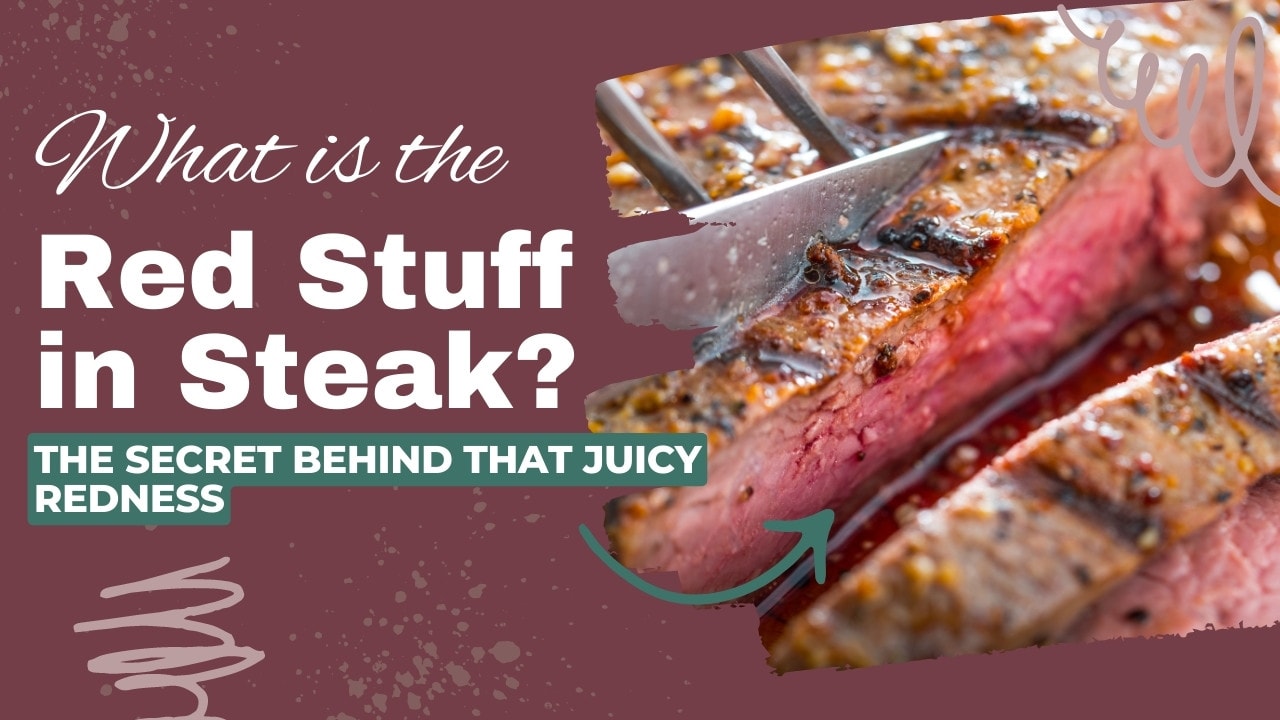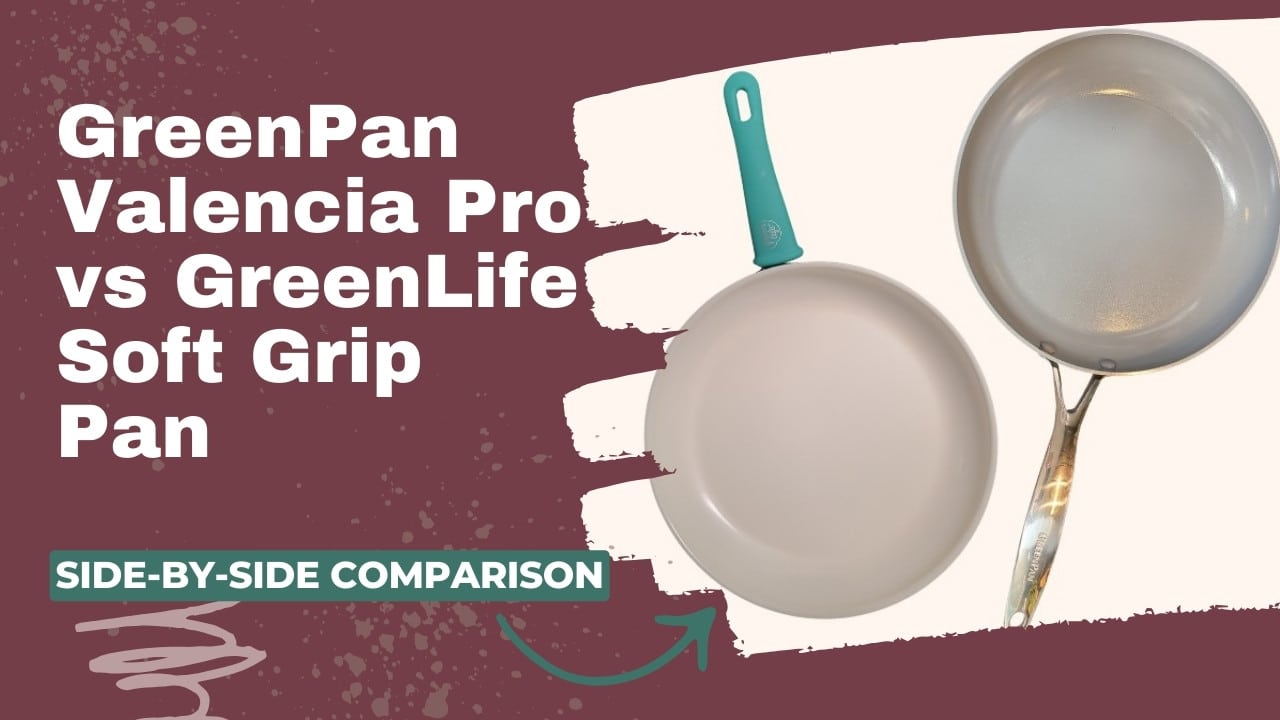You’re about to slice into the steak you were so excited about – and then you notice a red liquid seeping from it. And then, you stop. Wait. Something red is leaking out of it. Is that blood? Is it safe to eat?
If you notice a red liquid coming from your steak, don’t be alarmed. it’s actually not blood at all! Most blood is removed from meat at the time the animal is slaughtered.
So if it isn’t blood, what is the red stuff in steak? It’s actually a mixture of water and a protein known as myoglobin. Let’s learn more about myoglobin and how it affects the texture and flavor of a steak.
Is the Red Stuff In Steak Blood?
So, what is the rest stuff in steak? The “red stuff” seeping from your steak is a protein called myoglobin. Myoglobin helps oxygen travel through an animal’s body to reach all the muscles.
When the protein is exposed to oxygen it turns red. When a steak is cut, the myoglobin is exposed to the air – so it turns red – and starts to leak from the steak as the muscles loosen.
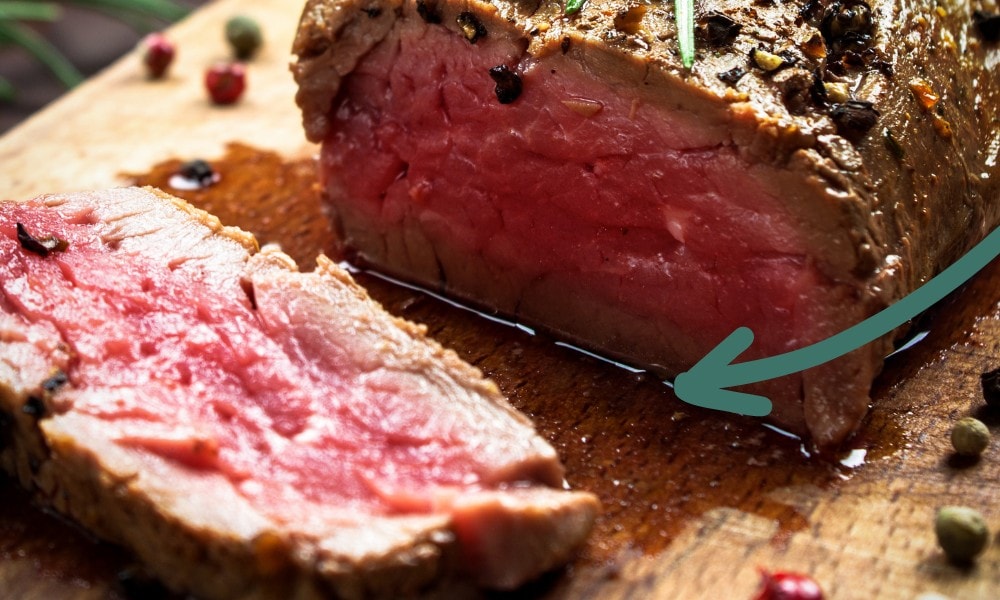
The appearance might turn you off, but it is safe to eat and is actually full of nutrients. While it does have a subtle iron taste, most people don’t feel that it negatively affects the flavor of a steak.
Why Does Steak Have Myoglobin?
Steak has myoglobin because it is present in live animals and helps carry iron and oxygen to the muscles. At the time an animal is slaughtered, the myoglobin is absorbed into the muscle and stays there until the meat is cut.
The myoglobin isn’t usually noticeable until it leaks out of the steak onto a cutting board, plate, or container it is packaged in.
Sometimes the myoglobin drains out of the steak before it is cooked. Sometimes cooking releases muscle tissue that was holding the myoglobin and allows it to leak out.
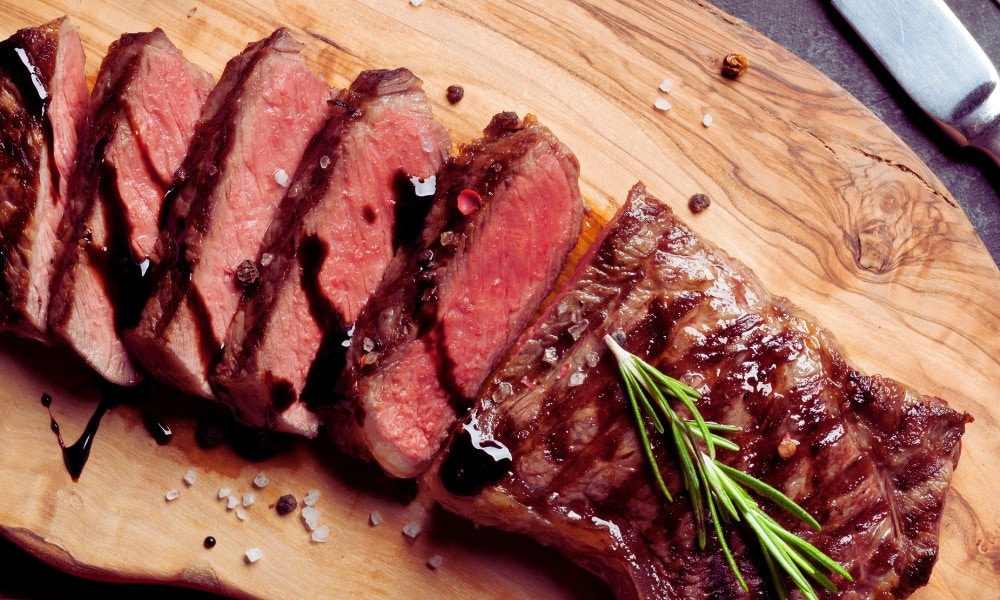
Does Myoglobin Change Colors?
Myoglobin changes colors for two reasons: when temperature changes and when it is exposed to oxygen. Once the myoglobin is exposed to air it turns red. When the steak is cooked, the heat also makes the myoglobin darker.
The higher the temperature, the darker the myoglobin becomes. Steaks that are cooked until they are well done tend to have darker juice (or myoglobin) because they have been cooked longer and the temperature inside the steak gets higher.
Steaks that are cooked to be rare may appear very red, as the myoglobin has not been heated as much and will not show such a drastic change. Raw steaks appear bright red because the myoglobin has just recently been exposed to oxygen, and has not been heated at all.
Sometimes the older a steak gets, the darker the myoglobin can get too.
Is It Safe To Eat Myoglobin?
It is safe to eat myoglobin. And, if you eat a lot of meat, you have probably already consumed a lot of it! Since myoglobin helps give steak and other meat its color– because, and when chefs pick out their meat, they usually consider the color first – myoglobin can be perceived as a good thing!
Without myoglobin, steak would appear gray or brown. And nobody really wants a gray or brown steak. Most of the myoglobin cooks out of a steak during the grilling or searing process– but what remains is perfectly safe.
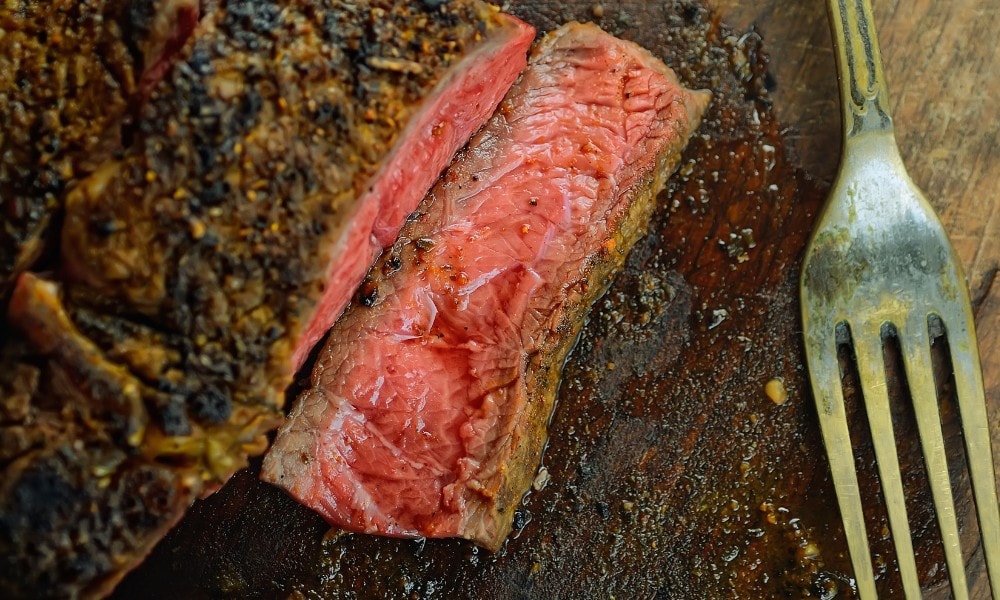
Myoglobin itself contains a lot of nutrients and protein, so eating it can actually be healthy!
Does Myoglobin Have Flavor?
Myoglobin does not have a specific flavor of its own. In fact, it’s more likely to absorb the flavor of the meat.
Since myoglobin’s role in the body is to transport iron and oxygen, some people can taste a metallic flavor when there is a lot of myoglobin present. Others don’t notice any flavor at all. If you are worried about how the myoglobin might affect the taste of your steak, you can try to rinse it out or use a marinade to help cover it up.
Marinades, especially injectable ones, help add juice and flavor to the steak. They can help flush out the myoglobin so it’s no longer present in the steak when you cook it and can replace the flavor of the myoglobin with the flavor of the marinade.
How Do You Get Myoglobin Out Of A Steak?
If you prefer to remove the myoglobin from your steak, you will need to do so before you cook it. Cooking the steak redistributes the myoglobin throughout the tissue and makes it hard to remove.
If you remove the myoglobin from the steak, you risk pulling flavor out with it. But if you still want to do it, here’s how.
You can pull out some of the myoglobin by placing the raw steak on top of a drying rack and layering paper towels underneath it. Add salt to all sides of the steak. It may be easier to roll the steak in salt before you put it on the rack.
Let the steak sit in your refrigerator on the rack for at least 12 hours. The salt helps to pull out the myoglobin and will allow it to drip onto the paper towels. This also helps to make the steak moist.
Instead of the juices staying in one part of the steak, the brining or salting helps them move around and be distributed through the steak where they can break down the tougher parts of the meat.
As the salt pulls out the myoglobin, it is also absorbed into the meat. It can then help break down some of the lean muscle tissue in the steak, to help make it tender.
You can wipe off the excess salt before you cook the steak or you can leave it on the steak so when you sear it, it creates a flavorful crust.
How Do You Keep A Steak Juicy?
A juicy steak is a tasty steak. Luckily there are ways to make a steak extra juicy and flavorful. Whether you are cooking your first steak or are an experienced chef who just needs to add more flavor to the meat, the steak cooking tips will rock your world and have your guests begging for more.
Tenderize It
Physically breaking down some of the protein and lean muscle in the steak will help relax the meat and make it more tender. It will also allow the juices to be distributed through the meat more evenly as it cooks, adding more flavor.
You can use a metal meat tenderizer to do this, or you can use a tenderizer seasoning. Salting the meat and allowing it to sit overnight in the refrigerator is another of my favorite methods.

Cook It Long And Low
You may be in a hurry to sink your teeth into your dinner, but cooking your steak on low heat for a long time helps to keep the juices inside the meat and makes it more flavorful.
A reverse sear is a great cooking method to try. Cook the steak at a low temperature to maintain its juiciness. Once the steak is almost done, remove it from your oven and sear it to lock in the flavor.
The longer the steak cooks, the more tissue and protein gets broken down and distributed throughout the meat. Cooking the meat too fast will force the juices out of the meat, prevent the tissues from becoming tender, and dry out the steak.
Heat causes the muscle proteins in the steak to contract. The higher the heat, the faster they contract and the more water or liquid that is shed during the cooking process. Cooking the steak at a lower temperature allows it to maintain its juices.
Use A Marinade
Marinades fill the steak with flavor. It’s also less likely to dry out in the cooking process when it’s marinated in salt, because salt retains moisture. Let your steak rest in a marinade overnight to absorb all the flavor and juices before you cook it.
Let It Rest Before And After Cooking
Don’t take your steak straight out of the fridge and toss it on heat. This will cause it to seize up and trap the juices in small areas of the steak. Instead, let it come to room temperature so the meat can relax and let the juices spread throughout it.
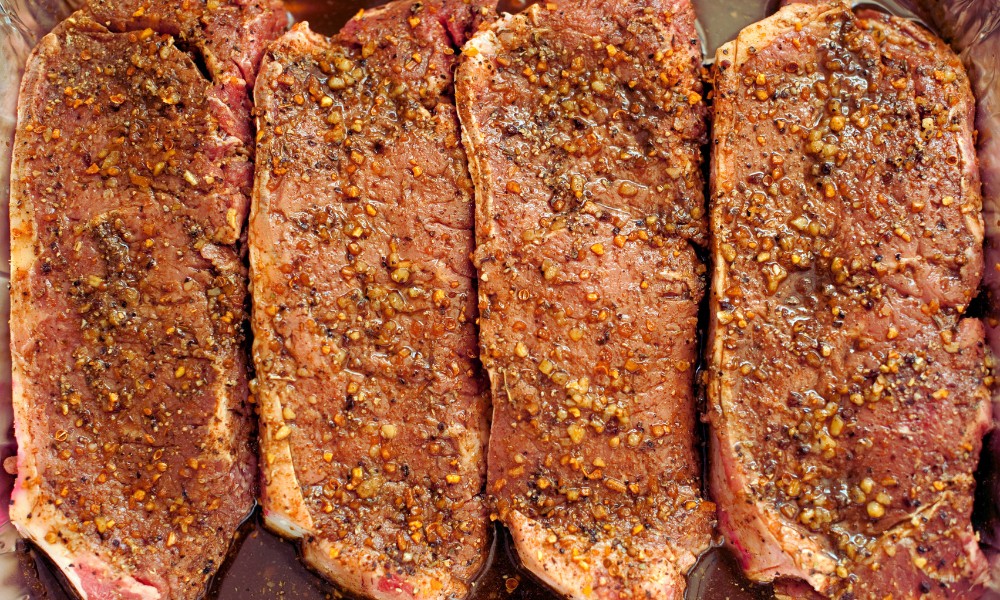
Once you have cooked your meat, give it some time to rest before you cut it. This again lets the juices redistribute throughout the steak. They are less likely to run out when it is cut and will help make the steak more flavorful.
Conclusion
If you assumed that the red liquid in steak is blood, you’re not alone. But actually, it’s water carrying the protein myoglobin. The sight of it might be off-putting– but it helps make the steak more nutritious and flavorful.
You can pull some of the myoglobin out of the steak before cooking if you are sensitive to its subtle iron taste.
Using marinades and cooking your steak properly can help distribute the myoglobin through the steak. This will not only make the myoglobin less noticeable, but helps make the steak juicy and tender.
Does watching the myoglobin run from your meat turn you off? Or does it not bother you? If you have any other methods for using or removing myoglobin, be sure to share them with us!

